
The Statista Vietnam report brings a comprehensive look through 5 chapters, including the Population, Economy, National finances, ASEAN country comparison, and how Vietnam was affected by the coronavirus in recent years.
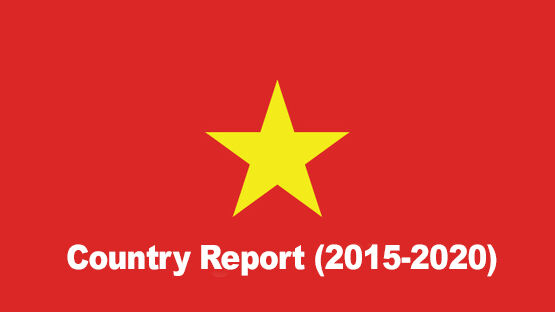
The Statista Vietnam report brings a comprehensive look through 5 chapters, including the Population, Economy, National finances, ASEAN country comparison, and how Vietnam was affected by the coronavirus in recent years.
The total population in Vietnam from 2016 to 2026 will increase steadily. The total population in 2016 reached 92.7 million people. This number in 2021 is forecast to be at 98.32 million. In reality, the population of Vietnam as of July 4, 2021, is 98,176,244 people, according to the U.N. - United Nations data. In 2026, the population is predicted to reach 102,54 million inhabitants.

The fertility rate from 2008 to 2018 is increasing; in 2008, the number of children born per woman was 1.92, the one in 2018 was 2.05. The birth rate per thousand population in Vietnam in 2008 at 17.13, and it increased steadily to 2014 at 17.33. The ratio started to decrease from 2014 at 17.32 to 16.75 in 2018.
Life expectancy at birth in 2008 in Vietnam is around 75 years; this number increases steadily and reaches 75.32 years in 2018. In 2019, Vietnam's population aged from 0-14 years accounting for 23.21% of the total population, 69.23% of the total population from 15-64 years, and 7.55% over 65 years. The average age of the population in Vietnam in 1950 was 24.5 and showed a decrease for the next continuous years to get the lowest number at 18.2 in 1970. The average age started to rise again at 18.3 in 1975 and increase steadily to 32.5 in 2020. According to the United Nations ' data, this average age of the population is predicted to be 41.2 in 2050.
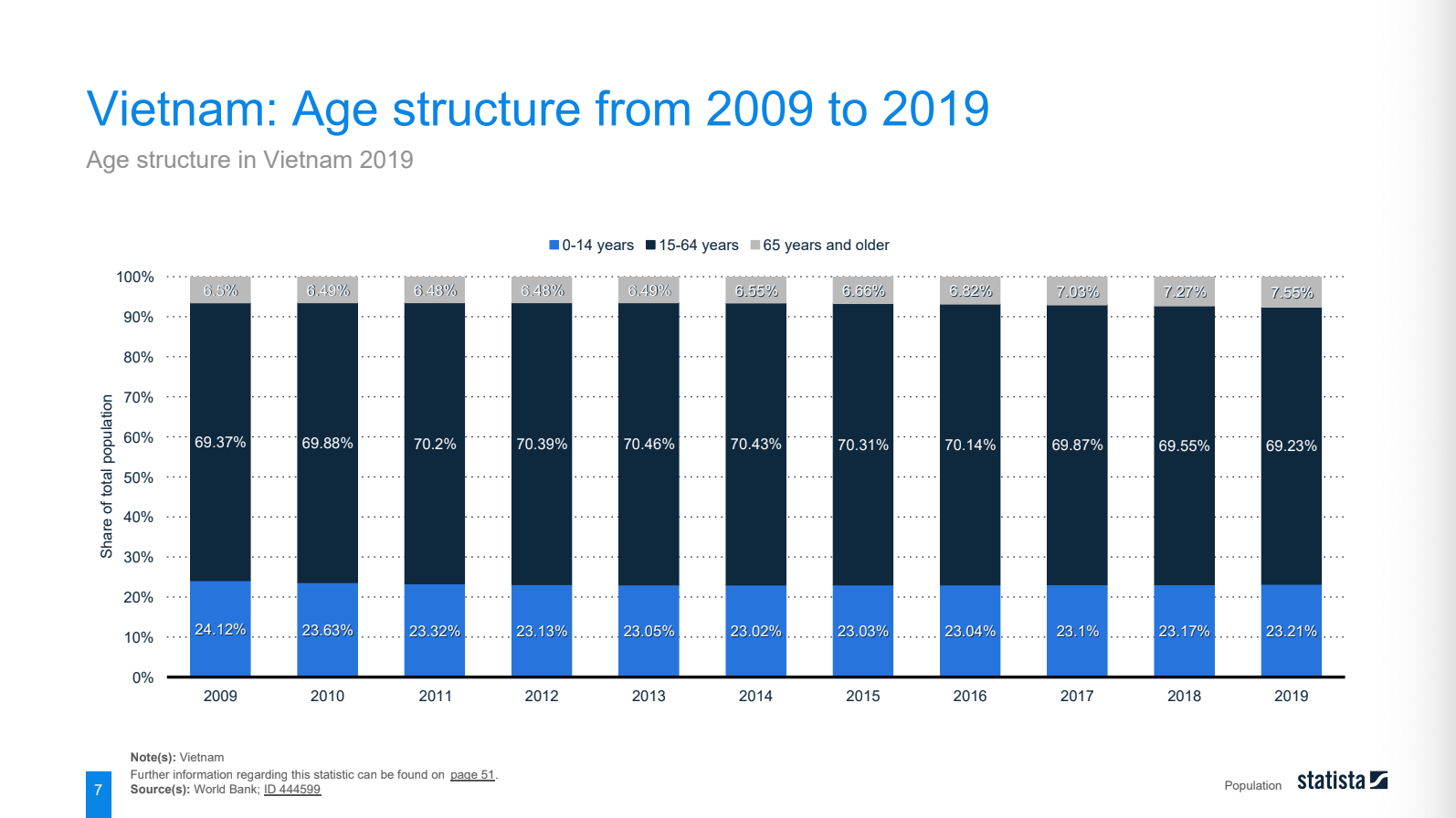
The death rate in Vietnam tends to increase from 2008 to 2018. In 2008, an average of 5.72 people per 1000 deaths. This number in 2018 is 6.32 people per 1000 people. In addition, the infant mortality rate from 2009 to 2019 shows a steady downward trend. In 2009, an average of 1000 babies had 18.5 infant deaths. This number decreased to 15.9 in 2019.
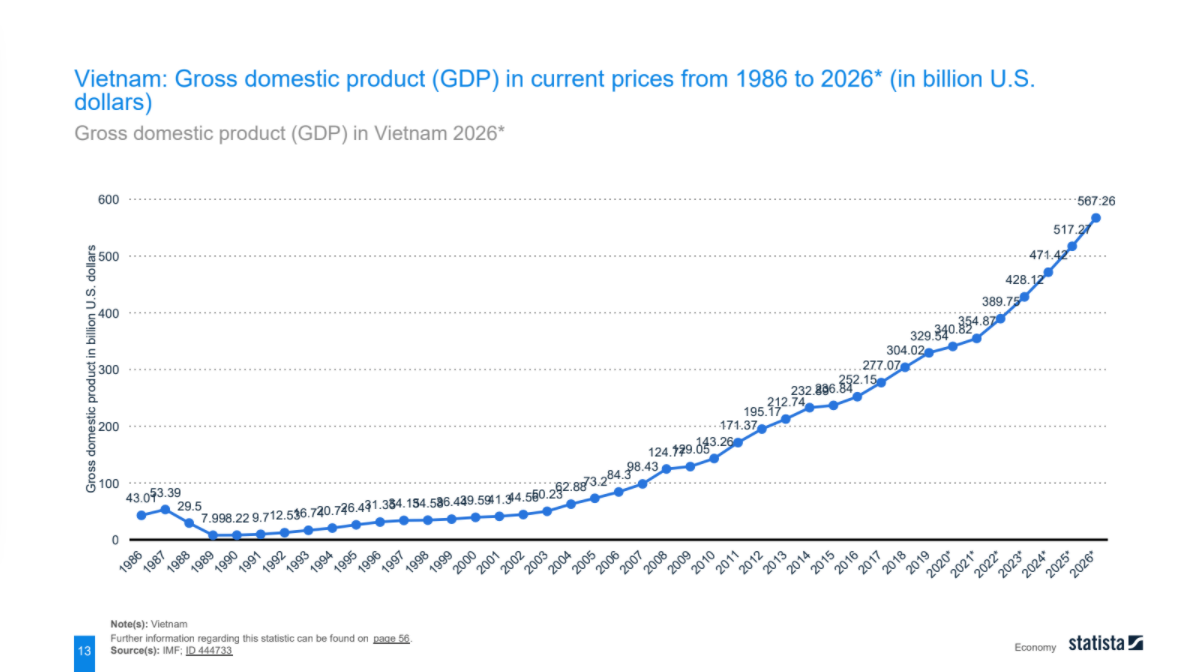
The development of Vietnam over the past 30 years is remarkable. Economic and political reforms since 1986 bring Vietnam from one of the poorest countries in the world to a low-middle-income country. From 2002 to 2018, GDP per capita increased 2.7 times, reaching over US$3,200 in 2019. The GDP in Vietnam is predicted to increase by more than 340 billion USD in 2021.

In reality, Vietnam's economy was heavily affected by the COVID-19 pandemic, GDP growth is estimated at 2.9% in 2020 compared to the previous year, reaching 271.16 USD billion, and GDP per capita reaching US$2123.46. This number is hoped to increase for the following years, with a growth rate of 7.2% in 2022 compared to previous years and at the range of more than 6% from 2023 to 2026.
Agriculture, forestry, and fishing sectors decreased by 5.21% in 2019 compared to 2009, contributing 13.96% in the total value of the total GDP in Vietnam 2019; the Industry (including construction) sector decreased by 2.9%, accounting for 34.49% of gross domestic product (GDP) Vietnam 2019. The share of GDP in the Service sector fell sharply between 2009 and 2010, from 43.44% to a 2012 low of 37.27%. This index tends to increase again in the following years and reaches 41.64% in 2019, helping the service industry have the most significant contribution to the country's GDP.
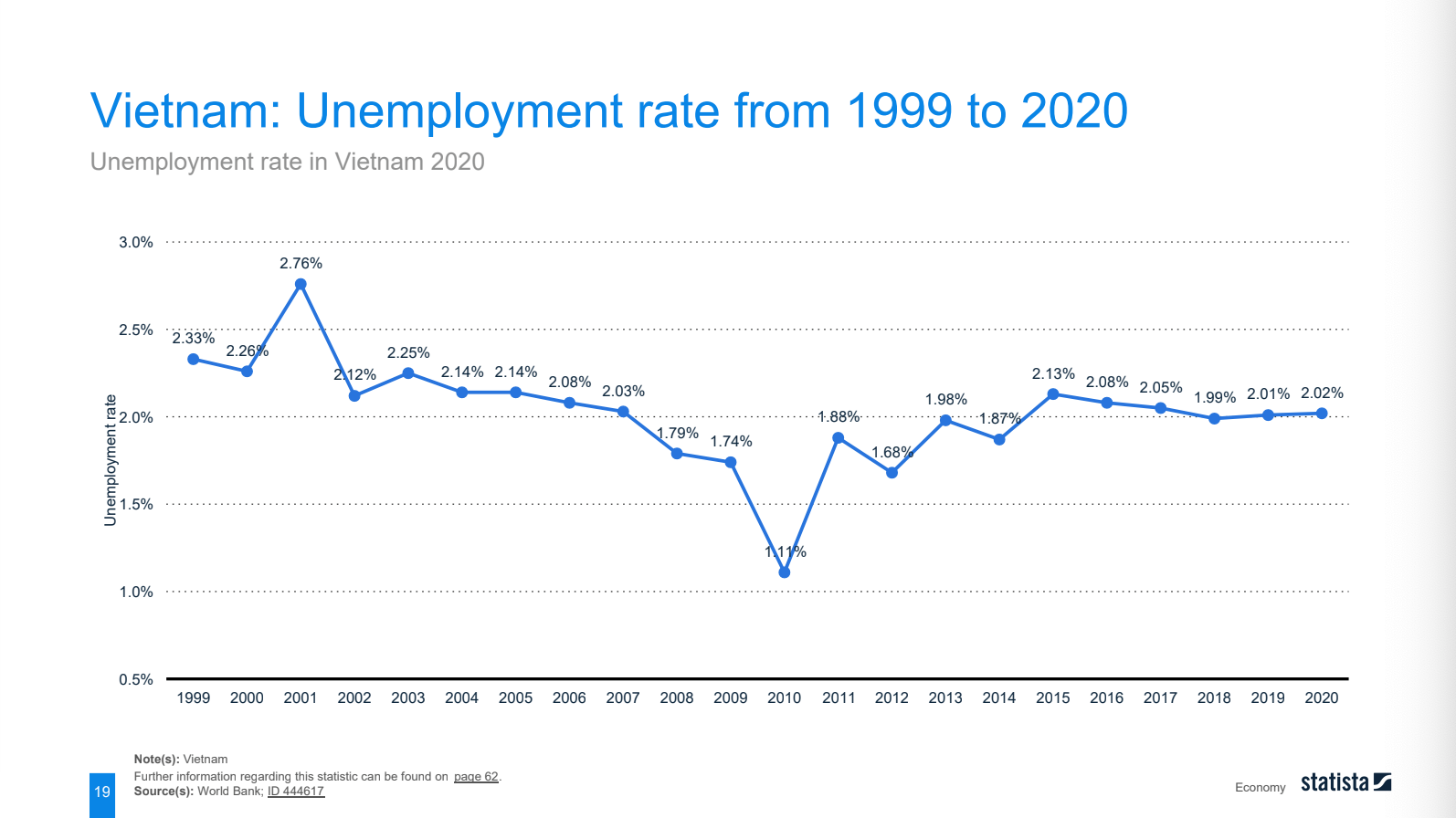
The unemployment rate from 1999 to 2020 enormously fluctuated by many factors. The Unemployment rate in Vietnam has decreased from 1999 to 2000 at 2.26%, then strongly increased to the ratio of 2.76% in 2001 and strongly decreased in the following year to reach the lowest rate at 1.11% before rising again in 2011. The number of youth unemployed people aged 15-24 years old from 1999 to 2010 strongly fluctuated; the lowest youth unemployment rate was 3.37 in 2010. It tended to increase sharply in the following years; this ratio is around more than 7% from 2017 to 2020.
The total import of goods reached US$253.9 billion, up 363% since 2009 (the import value is US$69.95 billion). The main import partners in 2019 from China, South Korea, and Japan, with a share in the total import, are 35%, 18%, and 6%, respectively. The total export of goods from 2009 to 2019 increased rapidly, reaching over US$264.27 billion US$ compared to the export value of US$57.1 billion in 2009. Main export partners for Vietnam in 2019 include the United States, China, Japan, South Korea, with a share in total exports of 23%, 14%, 8%, and 7%, respectively.
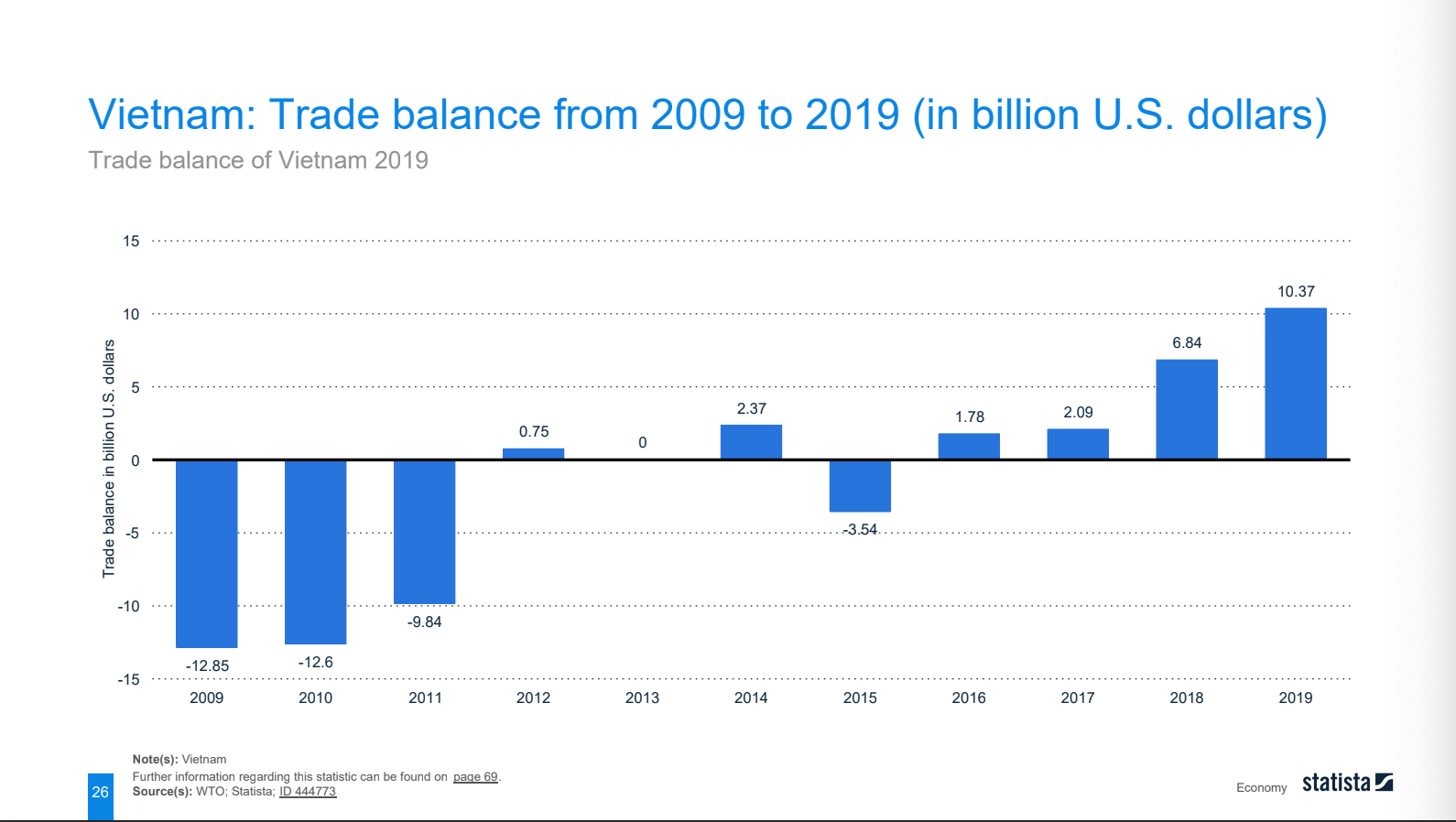
According to the General Statistics Office data, Vietnam's total import and export turnover in 2019 was estimated at 516.96 billion USD. In 2019, the merchandise trade balance was estimated to be 9.9 billion USD, the highest level in 4 years of consecutive super exports.
By the end of 2020, the national public debt is equivalent to 55.3% of the economy's GDP, of which foreign debt accounts for 47.3% of GDP, lower than the ceiling assigned by the National Assembly in the 5-year financial plan 2016-2020. According to the report, the national debt is predicted to increase in the following years and maybe reach 282.75 billion USD; national debt accounts for 45.65% of GDP.

This section of the report shows us the total population of the ASEAN countries from 2011 to 2021. Indonesia is the most populous, with a total population of 270.6 million in 2019. According to the report's data, this number is predicted to increase for the following years and reach 300 million in 2021. In reality, the total population of Indonesia is 276,937,059 based on projections of the latest United Nations data. The ranking based on the large of the total population is as follows: Philippines, Vietnam, Thailand, Myanma, Laos, Singapore, Brunei.
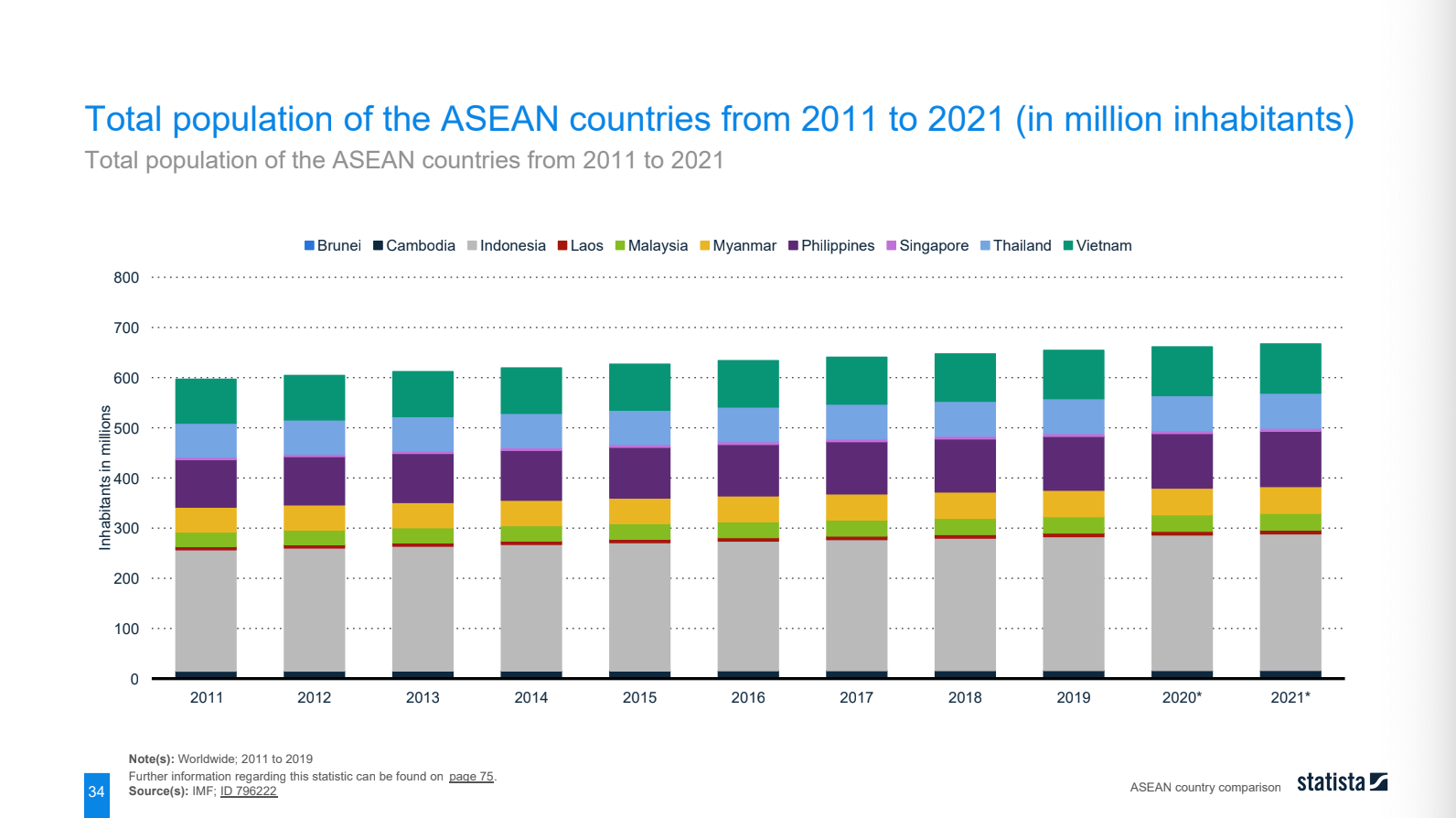
Import trade growth of the ASEAN region in 2015 showed positive signs in Vietnam, Laos, Myanmar, and the Philippines, and other countries including Thailand, Brunei, Malaysia, Singapore, Indonesia, and Cambodia showed a profoundly negative import balance, respectively.
The report shows the export trade growth in the ASEAN region by country in 2015. In detail, the value of all exports in Malaysia rose by approximately 14.6% from the previous year. In 2019, the country across the ASEAN region with the highest trade balance was Malaysia, with a trade balance of approximately 33 billion U.S. dollars. The Philippines had the lowest trade balance, with a negative trade balance of -46.45 billion U.S. dollars in 2019.
As of July 13, 2021, coronavirus disease (COVID-19) had infected more than 188 million people worldwide, and deaths had reached more than four million. The most severely affected countries include the U.S., Brazil, and India. The number of infected cases was more than 34 million people in the USA, around 31 million people infected in India, and nearly 20 million infected in Brazil.

As of July 13, 2021, there were around 4 million cases of novel coronavirus (COVID-19) deaths worldwide. The USA confirmed 623 thousand deaths due to novel coronavirus, Brazil and India had similar bad situations as these countries confirmed the number of deaths of more than 400 to 500 thousand people.
As of September 2021, Vietnam is facing the second wave of novel coronavirus with the Delta Variable, which has put this country in a worse situation than the previous year. Since the epidemic outbreak in 2020, Vietnam has recorded 613,000 infections, 374,578 people recovered, 223,521 patients are being treated, and more than 15.000 deaths.
This report from Statista brings a comprehensive look at Vietnam's population, economy, and how this country could be affected by the pandemic in the next few years. The detailed data in this report will show you more about the economic strength and Vietnam's economic development potential in the coming years. You can download our full report directly by clicking on the link on top of the article. Please let us know if you need any support and advice.